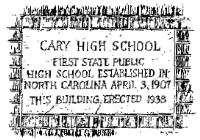About Our School

History of Cary Elementary All subject matter and images used on this web page are from Around and About Cary (Second Edition-1994).
Written by Thomas M. Byrd; Illustrated by Jerry Miller
Citizens of Cary have been able to look down South Academy Street since 1879 and see a school. Three different buildings have stood on the site now occupied by the main building of Cary Elementary School.
Frank Page set aside this prominent place for the "school lot" when he laid out the village about 1869. A wooden, two-story, four-room school was ready by the next year. Timber for the building was cut from the site and sawed at Page's mill. Students dug up the stumps as punishment for misbehavior. Named Cary Academy, it was a private boarding school that drew students from a wide area.
The first teacher at Cary Academy was A. Howard Merrit, a graduate of the University of North Carolina. Another early teacher was the Reverend Soloman S. Pool, who had been president of the University when it closed in 1870 in the aftermath of the Civil War.
Page sold one-third interest in the academy (for $800) to Rufus Jones in 1873.Then, in 1886, he sold his remaining interest to two of Jones' daughters, Sarah and Loulie. "Miss Loulie," along with another sister, "Miss Lilly," became two of the school's best known teachers.
A new era for the school began in 1896, when it was incorporated as Cary High School by C. W. Blanchard, F. R. Gray, C. W. Scott, A. D. Hunter, J. C. Angier, and J. E. White. Under principal E. L. Middleton, Cary High soon began to make a name for itself. Stockholder Angier, using his Duke connections, arranged for Trinity College President John C. Kilgo to come over in 1898 for an inspection and an address. He also gave Principal Middleton an endorsement for use in the school's promotional literature.
In 1900, Cary High School offered two five-month terms, the first one beginning in early August. "Going to school in August nearly killed us for the remainder of the year," recalled Effie Adams Poplin, a 1904 graduate.
It is important to remember that Cary's first school was private, built for the sons and daughters of people who could afford to send them there. Several other private schools were started in the area, but Cary Academy was the first one to get beyond the one-room, one-teacher stage, and it was the only one to leave a permanent legacy.
Cary High School became a model for the statewide system of public high schools that followed. It received strong local support, offered innovative programs, and continued to attract boarding students from a wide area. As a consequence, the school put the town "on the map." People all over the state began to associate "Cary" with "high school" just as they associated "Chapel Hill" with "university" and "Durham" with "tobacco." Cary had more upper grade pupils and boarding students in 1913 than any of the 200 state-assisted high schools.
In 1913, Cary became one of the first high schools in the state to offer vocational agriculture and home economics. Cary High School evolved into an impressive campus of brick buildings. In addition to the main building, it had the Frank Page Dormitory for girls erected in 1916, the new dormitory for boys completed in 1920, the Walter Hines Page Building for vocational education completed in 1922, the J. M. Templeton Physical Education Building erected in 1925, and the Marcus Dry Building erected in 1927 to handle the influx of new students resulting from consolidation.
Students in 1928 could work for one of four diplomas: academic, agriculture, home economics, or teacher training. Students could also take piano and violin; join the Irving, Calhoun, or Lowell literary society; participate in gymnastics, track, folk dancing, baseball, basketball, football, and tennis; join the science, glee, and drama clubs; take typing, shorthand, and book-keeping; and assist the site (annual) staff.
The model structure erected in 1913 as the school's main building had a short life. It was torn down in 1938 to make way for a new $132,00 building. Governor Clyde Hoey, who came out for the dedication on March 2, 1940, called Cary "a beacon of hope and inspiration to other communities of the state."
Cary High School, with its predecessor, Cary Academy, has occupied a position of leadership in the field of secondary education, not only in Wake County, but in the state as a whole for 75 years.




